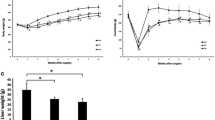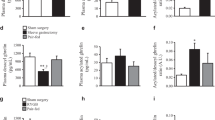Abstract
Background
We interrogate effects of gastric bypass (RYGB), compared with a low-calorie diet, on bile acid (BA), liver fat, and FXR, PPARα, and targets in rats with obesity and non-alcoholic fatty liver disease (NAFLD).
Methods
Male Wistar rats received a high-fat diet (obese/NAFLD, n=24) or standard chow (lean, n=8) for 12 weeks. Obese/NAFLD rats had RYGB (n=11), sham operation pair-fed to RYGB (pair-fed sham, n=8), or sham operation (sham, n=5). Lean rats had sham operation (lean sham, n=8). Post-operatively, five RYGB rats received PPARα antagonist GW6417. Sacrifice occurred at 7 weeks. We measured weight changes, fasting total plasma BA, and liver % steatosis, triglycerides, and mRNA expression of the nuclear receptors FXR, PPARα, and their targets SHP and CPT-I.
Results
At sacrifice, obese sham was heavier (p<0.01) than all other groups that had lost similar weight loss. Obese sham had lower BA levels and lower hepatic FXR, SHP, and CPT-I mRNA expression than lean sham (P<0.05, for all comparisons). RYGB had increased BA levels compared with obese and pair-fed sham (P<0.05, for both), while pair-fed sham had BA levels, similar to obese sham. Compared with pair-fed sham, RYGB animals had increased liver FXR and PPARα expression and signaling (P<0.05). Percentage of steatosis was lower in RYGB and lean sham, relative to obese and pair-fed sham (P<0.05, for all comparisons). PPARα inhibition after RYGB resulted in similar weight loss but higher liver triglyceride content (P=0.01) compared with RYGB alone.
Conclusions
RYGB led to greater liver fat loss than low-calorie diet, an effect associated to increased fasting BA levels and increased expression of modulators of liver fat oxidation, FXR, and PPARα. However, intact PPARα signaling was necessary for resolution of NAFLD after RYGB.






Similar content being viewed by others
References
Musso G, Cassader M, Rosina F, Gambino R. Impact of current treatments on liver disease, glucose metabolism and cardiovascular risk in non-alcoholic fatty liver disease (NAFLD): a systematic review and meta-analysis of randomised trials. Diabetologia. 2012;55(4):885-904.
Chalasani N, Younossi Z, Lavine JE, Charlton M, Cusi K, Rinella M, et al. The diagnosis and management of nonalcoholic fatty liver disease: practice guidance from the American Association for the Study of Liver Diseases. Hepatology. 2018;67(1):328-57.
Lassailly G, Caiazzo R, Buob D, Pigeyre M, Verkindt H, Labreuche J, et al. Bariatric surgery reduces features of nonalcoholic steatohepatitis in morbidly obese patients. Gastroenterology. 2015;149(2):379-88; quiz e15-6.
Lee Y, Doumouras AG, Yu J, Brar K, Banfield L, Gmora S, et al. Complete resolution of nonalcoholic fatty liver disease after bariatric surgery: a systematic review and meta-analysis. Clin Gastroenterol Hepatol. 2019;17(6):1040-60.e11.
Mazzini GS, Khoraki J, Dozmorov M, Browning MG, Wijesinghe D, Wolfe L, et al. Concomitant PPARalpha and FXR activation as a putative mechanism of NASH improvement after gastric bypass surgery: a GEO datasets analysis. J Gastrointest Surg. 2019;23(1):51-7.
Schauer PR, Bhatt DL, Kirwan JP, Wolski K, Aminian A, Brethauer SA, et al. Bariatric surgery versus intensive medical therapy for diabetes - 5-year outcomes. N Engl J Med. 2017;376(7):641-51.
Sjostrom L. Review of the key results from the Swedish Obese Subjects (SOS) trial - a prospective controlled intervention study of bariatric surgery. J Intern Med. 2013;273(3):219-34.
Kardassis D, Bech-Hanssen O, Schonander M, Sjostrom L, Petzold M, Karason K. Impact of body composition, fat distribution and sustained weight loss on cardiac function in obesity. Int J Cardiol. 2012;159(2):128-33.
Rabl C, Campos GM. The impact of bariatric surgery on nonalcoholic steatohepatitis. Semin Liver Dis. 2012;32(1):80-91.
Chavez-Talavera O, Tailleux A, Lefebvre P, Staels B. Bile acid control of metabolism and inflammation in obesity, type 2 diabetes, dyslipidemia, and nonalcoholic fatty liver disease. Gastroenterology. 2017;152(7):1679-94.e3.
Browning MG, Pessoa BM, Khoraki J, Campos GM. Changes in bile acid metabolism, transport, and signaling as central drivers for metabolic improvements after bariatric surgery. Current obesity reports. 2019;8(2).
Steinert RE, Peterli R, Keller S, Meyer-Gerspach AC, Drewe J, Peters T, et al. Bile acids and gut peptide secretion after bariatric surgery: a 1-year prospective randomized pilot trial. Obesity (Silver Spring). 2013;21(12):E660-8.
Fouladi F, Mitchell JE, Wonderlich JA, Steffen KJ. The contributing role of bile acids to metabolic improvements after obesity and metabolic surgery. Obes Surg. 2016;26(10):2492-502.
Hue L, Taegtmeyer H. The Randle cycle revisited: a new head for an old hat. Am J Physiol Endocrinol Metab. 2009;297(3):E578-91.
Li T, Chiang JY. Regulation of bile acid and cholesterol metabolism by PPARs. PPAR Res. 2009;2009:501739.
Pineda Torra I, Claudel T, Duval C, Kosykh V, Fruchart JC, Staels B. Bile acids induce the expression of the human peroxisome proliferator-activated receptor alpha gene via activation of the farnesoid X receptor. Mol Endocrinol. 2003;17(2):259-72.
Mazzini GS, Khoraki J, Browning MG, Campos GM. Concurrent miR-21 suppression and FXR activation as a mechanism of improvement in nonalcoholic fatty liver disease. Cell Death Dis. 2018;9(3):354.
C S, C S, M V, P R, MR B, S B, et al. Palmitoylethanolamide controls reactive gliosis and exerts neuroprotective functions in a rat model of Alzheimer's disease. Cell death & disease. 2014;5(9).
Bruinsma BG, Uygun K, Yarmush ML, Saeidi N. Surgical models of Roux-en-Y gastric bypass surgery and sleeve gastrectomy in rats and mice. Nat Protoc. 2015;10(3):495-507.
St John-Williams L, Mahmoudiandehkordi S, Arnold M, Massaro T, Blach C, Kastenmuller G, et al. Bile acids targeted metabolomics and medication classification data in the ADNI1 and ADNIGO/2 cohorts. Scientific data. 2019;6(1):212.
Folch J, Lees M, Sloane Stanley GH. A simple method for the isolation and purification of total lipides from animal tissues. The Journal of biological chemistry. 1957;226(1):497-509.
Kersten S, Stienstra R. The role and regulation of the peroxisome proliferator activated receptor alpha in human liver. Biochimie. 2017;136:75-84.
B S, JC F. Therapeutic roles of peroxisome proliferator-activated receptor agonists. Diabetes. 2005;54(8).
Videla LA, Pettinelli P. Misregulation of PPAR functioning and its pathogenic consequences associated with nonalcoholic fatty liver disease in human obesity. PPAR Res. 2012;2012:107434.
Francque S, Verrijken A, Caron S, Prawitt J, Paumelle R, Derudas B, et al. PPARalpha gene expression correlates with severity and histological treatment response in patients with non-alcoholic steatohepatitis. J Hepatol. 2015;63(1):164-73.
Lefebvre P, Lalloyer F, Bauge E, Pawlak M, Gheeraert C, Dehondt H, et al. Interspecies NASH disease activity whole-genome profiling identifies a fibrogenic role of PPARalpha-regulated dermatopontin. JCI Insight. 2017;2(13).
Barrett T, Wilhite SE, Ledoux P, Evangelista C, Kim IF, Tomashevsky M, et al. NCBI GEO: archive for functional genomics data sets--update. Nucleic Acids Res. 2013;41(Database issue):D991-5.
Browning MG, Campos GM. Bile acid physiology as the potential driver for the sustained metabolic improvements with bariatric surgery. Surg Obes Relat Dis. 2017;13(9):1553-4.
Risstad H, Kristinsson JA, Fagerland MW, le Roux CW, Birkeland KI, Gulseth HL, et al. Bile acid profiles over 5 years after gastric bypass and duodenal switch: results from a randomized clinical trial. Surg Obes Relat Dis. 2017.
Ryan KK, Tremaroli V, Clemmensen C, Kovatcheva-Datchary P, Myronovych A, Karns R, et al. FXR is a molecular target for the effects of vertical sleeve gastrectomy. Nature. 2014;509(7499):183-8.
Author information
Authors and Affiliations
Corresponding author
Ethics declarations
Conflict of Interest
The authors declare that they have no conflict of interest.
Additional information
Publisher’s Note
Springer Nature remains neutral with regard to jurisdictional claims in published maps and institutional affiliations.
Rights and permissions
About this article
Cite this article
Mazzini, G.S., Khoraki, J., Browning, M.G. et al. Gastric Bypass Increases Circulating Bile Acids and Activates Hepatic Farnesoid X Receptor (FXR) but Requires Intact Peroxisome Proliferator Activator Receptor Alpha (PPARα) Signaling to Significantly Reduce Liver Fat Content. J Gastrointest Surg 25, 871–879 (2021). https://doi.org/10.1007/s11605-021-04908-3
Received:
Accepted:
Published:
Issue Date:
DOI: https://doi.org/10.1007/s11605-021-04908-3




